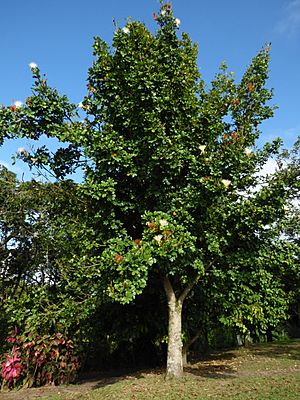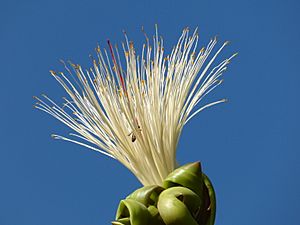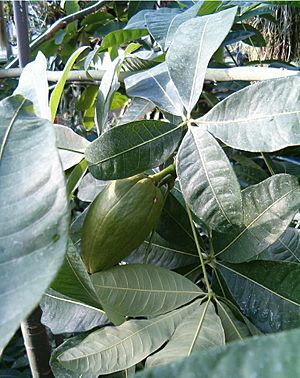Pachira glabra facts for kids
Quick facts for kids Pachira glabra |
|
|---|---|
 |
|
| Scientific classification | |
| Genus: |
Pachira
|
| Species: |
glabra
|
| Synonyms | |
|
|
Pachira glabra (say "Pa-CHEE-ra GLAB-ra") is a cool tropical tree that loves wet places. It's part of the mallow family, just like cotton or hibiscus! You can find it growing naturally along rivers in eastern Brazil. People often call it the Guinea peanut, French peanut, Saba nut, money tree, or lucky tree. It looks a lot like another tree called Pachira aquatica, and sometimes people get them mixed up! Both are used for food and as pretty plants.
Contents
Discovering the Pachira glabra Tree
This tree can grow quite tall, usually between 9 and 18 meters (about 30 to 60 feet) high. Its leaves are special because they look like a hand with 5 to 9 leaflets spreading out like a fan. The bark is smooth and greenish-gray, and even when the tree is young, its trunk often gets wider at the bottom.
Flowers and Fruit of Pachira glabra
The Pachira glabra has large, white, and very fragrant flowers. They grow on a long stalk and open up at night. By the middle of the next day, they usually fall off.
After the flowers, the tree grows smooth green fruits. These fruits are about 10 to 20 centimeters (4 to 8 inches) long. When they are ready, they split open naturally. Inside, you'll find 10 to 25 round, brown seeds. Each seed is about 2.5 centimeters (1 inch) across.
Where Pachira glabra Grows
This tree is very tough and can grow in many different kinds of soil. It does well in full sunshine or in places with some shade. The Pachira glabra can handle both dry weather and floods, which makes it very adaptable!
Uses of the Pachira glabra Tree
People use Pachira glabra for different things, especially for food and as a decorative plant.
Pachira glabra as Food
In West and Central Africa, Pachira glabra is grown as a food crop. The seeds are very healthy! They are full of oil and have a lot of protein (16%) and fat (40–50%). The seeds taste a bit like peanuts. People usually boil or roast them. Sometimes, roasted seeds are ground up to make a warm drink. Even the young leaves and flowers of the tree can be eaten!
Pachira glabra as an Ornamental Plant
Young Pachira glabra trees are popular as houseplants. They are easy to grow in flowerpots and can survive in many conditions, as long as it's not freezing cold. You might see them sold as "money trees" or "lucky trees." Often, several small trees are planted together in one pot, and their trunks are braided.
Many small ornamental plants sold as Pachira aquatica are actually Pachira glabra. It can be tricky to tell them apart! Here are some differences:
- Pachira aquatica has woody, gray bark, while Pachira glabra's bark is smoother and greenish-gray.
- Pachira aquatica only gets a swollen trunk when it's older, but Pachira glabra's trunk can be wide at the bottom even when young.
- The flowers of Pachira aquatica have red tips on their petals and red parts called anthers. Pachira glabra's flowers are all white.
- Pachira glabra seeds are green and about half the size of Pachira aquatica seeds.



